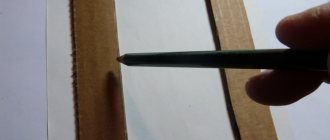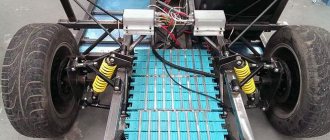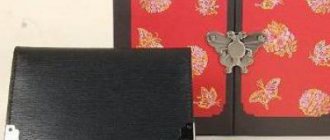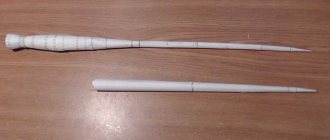A short excursion into history
This word comes from the Azerbaijani or Turkish manqal - brazier. There are similar words in Arabic, Persian, Georgian, and Armenian. It was a bowl made of copper with wide horizontal brims. For ease of carrying, it was equipped with two handles and was covered with a lid in the shape of a hemisphere. For stability, supports were placed from below. Somewhat later, skewers from the Syrian peak appeared, and the self-name shashlik came from the Tatar shishlyk - fried on a spit. Now it has firmly taken its place in the national cuisine of many peoples of the world.
Master classes on making barbecues
The work on creating a convenient design for cooking is quite complex; it requires the master to concentrate, carefully follow the sequence of actions and follow the scheme.
The fastest way
Suddenly guests arrived and offered to cook barbecue. There is nothing suitable for using your hand, but you can quickly make a simple barbecue from scrap materials. To do this, place two parallel rows of bricks on an edge on a sheet of iron.
We light a fire between them; when it burns out, we place skewers with meat on the hot coals. A way out of the situation has been found. But over time, it is better to get a specially made barbecue.
Material for production
Considering the antiquity of the technology for preparing such a dish, stones served as the material for the hearth. They are still successfully used in the form of barbecue ovens - popularly designated as garden ovens. But the most popular are metal barbecues.
The ability to transport them or simply move them at the owner’s request gives them a sense of freedom of choice. The metal for production can be bought at building materials stores or you can use scraps available in every yard.
We use old containers
If you find a 50-liter container for household gas, you can make a barbecue from a cylinder with your own hands.
For this:
- open the valve and completely bleed off the gas;
- fill with water and let sit for 24 hours to neutralize any remaining contents;
- We make a rectangular cutout on the side;
- we clean the edges and install hinges on the rivets;
- We cut off the valve, and in its place we weld a chimney pipe with a damper to adjust the draft.
In the same way, you can use steel barrels, but you also need to take “Soviet” ones with thick walls; they won’t burn out longer. With the help of decor, they can be transformed into a steam locomotive, airplane or rocket.
Many motorists have unnecessary rims, put them on a stand and you're done.
Use and care
After assembly, the grill should not be used yet, especially in situations where the metal used was not new.
First of all, it is immediately cleaned of dirt and rust that has formed on the material during operation or storage. A grinding machine or an ordinary drill with a specialized attachment is perfect for this.
If you decide to paint the grill, it is best to use heat-resistant acrylic paint.
If you don’t want to do this, but want the grill to shine, it needs to be blued. And first of all, to do this, degrease the surface by wiping it thoroughly with an alcohol solution.
Next, all the parts of the grill are placed in a solution of caustic soda and kept in it for about an hour and a half. This way you will not only make the grill beautiful, but also protect it with heat-resistant film, and also protect it from rust in the future.
Metal sheets
The traditional manufacturing option is to make a box in accordance with the drawing of the barbecue. The dimensions must be such as to accommodate the required number of skewers. To fix them along the length of the side, slots are made at the top.
There are holes at the bottom for ventilation. The height should be sufficient so that the food does not burn. To make cooking convenient, legs are made. For protection against corrosion and durability, it is advisable to paint it with black heat-resistant paint. It will not stand out against the background of soot.
Brazier and its characteristics
Its dimensions should allow the skewers to be placed with sufficient space between them. The width of the grill should be equal to the length of the skewers minus 12-18 cm. The length of the grill should be calculated on the basis that each skewer will have about 8-10 cm. The height above the coals should not be more than 10 cm, and the depth should be about 20-25 cm.
And, of course, for ease of cooking, it is necessary to have slots for skewers along its entire length. The wall thickness should be thick enough.
Also, there is no need to completely clean off the soot from the inside of the walls - after all, this gives a special taste to the meat. It is necessary to make holes in the side walls closer to the bottom to facilitate air flow.
We build a barbecue from bricks
Do-it-yourself brick grill - for this we need:
- the site is leveled at the selected location and the foundation is poured;
- the first layer of bricks is laid out strictly according to the level and checking the diagonals;
- subsequent laying must be carried out with bandaging between the rows at least a quarter;
- We take fire-resistant bricks and lay reinforcement for strength.
Types of barbecues
There are a huge number of options for making barbecues. They can be divided into several main types:
- Simple. This is a medium-sized rectangular product that can have removable legs and is easy to carry.
- Collapsible. This option is light weight and compact in size. It is convenient to take it with you on a picnic or on a hike. It can easily fit into a backpack.
- Stationary. A massive structure made of metal or brick, erected on a summer cottage or in the courtyard of a private house.
When choosing the appropriate type of structure for manufacturing, you should decide where and how it will be used.
When to combine with cooking
Instructions on how to make a grill oven:
- We select a suitable project taking into account your wishes;
- we make an additional compartment for the kitchen stove;
- we put a grate in the firebox, be sure to make a ash pan for better draft;
- cover the top with a cap with a chimney;
- We install a hob with burners; when cooking food, the mugs are removed; for better heating of the vessel, you can place a cauldron for pilaf.
Cutting and manufacturing
When marking, do not use chalk; it is better to do this with a sharpened rod. Drill holes along the fold line with a diameter of 10 mm and a pitch of 70 mm, go along the contour with a grinder, reducing the thickness of the metal. This will greatly simplify the work and will not require additional equipment.
The material will bend easily in weak areas. It is better to scald the ends with a corner; this will hide the defects of previous operations and give the product an aesthetic appearance. Cut grooves for skewers and drill holes for air access.
When it's bad weather outside
Snow, rain, and drizzle prevent you from enjoying the holiday, and they also prevent you from lighting a fire. In this case, a barbecue with a roof is required.
You can build a gazebo with a barbecue with your own hands. To do this, we choose a spacious area,
so that the wooden parts do not get hot from the heat source. We drive in the metal support posts and fasten the veins between them. We cover it with light and durable profiled sheets. They can also be secured on the sides for protection from the wind. We put a grill in the center and no vagaries of the weather are scary.
Note!
- How to make a garden (construction) wheelbarrow with your own hands: detailed instructions with description + 85 photos of fresh ideas
- How to make a bench with your own hands - 90 photos of the best ideas from the master. Review of finished drawings, diagrams and dimensions of the bench
- How to make a hot smoked smokehouse with your own hands: drawings, dimensions, choice of material, photos of finished options
DIY metal grill
To build the product you will need certain skills. You must be able to work with welding equipment, an angle grinder, and a drill. In addition, you will need a drawing, measuring instruments, metal corners, fittings, and sheet iron. Scrap metal can often be lying around as useless trash in a private yard, in which case it will be easier to create a barbecue with your own hands, and the costs of this venture will also be reduced.
Advantages and disadvantages of metal barbecues
The brazier is found everywhere. Some have purchased models, others prefer homemade ones. Products are fully welded, twisted with bolts. But they all have certain features, their own advantages and disadvantages. Let's look at them in more detail and consider the main advantages of metal structures:
- Price. If we talk about products made by hand, even if you buy all the metal components, the price of such an item will be significantly lower than the factory price. If we evaluate the material, then the cost of iron and steel is several times less than copper and stainless steel.
- Simplicity of design. The main models are represented by a box located on legs. After installing it, all that remains is to fill it up and light the wood or coals, and put in the skewers with meat.
- Safety. Due to the temperature obtained when burning raw materials, the metal does not melt or burn. It also retains heat, which helps the meat cook evenly.
- Mobility and functionality. Among the wide variety of models, there are compact collapsible ones that can be used anywhere: in the yard, outdoors, on the beach, on the terrace. Some products have additional elements, in the form of stands for firewood, hooks for skewers.
Disadvantages include the metal's susceptibility to oxidation. Some models, made of thin sheet steel, can quickly rust. Also, handmade products do not always have an attractive appearance.
Design and principle of operation
In general terms, what a barbecue is is clear from its definition. If we look in more detail, the standard models have a rectangular box made of steel. It consists of four side walls and a bottom - the basis of the entire fryer. The bottom wall is made thicker, which increases the durability of the item in question. Holes are drilled in the side partitions closer to the base. Such actions lead to improved air circulation; heat is not concentrated at one point, but is distributed evenly in the box.
The rectangular structure has legs. Usually there are four. These elements are made from reinforcement rods of different diameters, metal angles, forged products, round and profile pipes. The strength and type of material is selected taking into account the load applied and the preferences of the owner. Some legs may be pointed at the bottom, others have a flat base, it all depends on where they are installed.
The fryer has a simple operating principle. Charcoal and firewood are placed at the bottom of an iron box and set on fire. After the raw materials burn out and coals appear, they are evenly distributed along the bottom. Next, lay out skewers with pieces of meat strung on them, turning them periodically until the food is ready.
Types of structures
The model range is constantly growing, new inventions appear. They can be simple or have a complex structure. But all metal barbecues can be classified into certain types:
- Disposable. They can be built from any available means. There are factory options made of steel half a millimeter thick.
- Stationary. Large product. Installed in specially equipped places. It may have a roof or be located under a canopy. Often contains additional devices: chimney, smokehouse, various stands.
- Collapsible. They differ in the method of fastening the elements (latches, bolts). They have several design options. The simplest ones are two U-shaped metal stands. They are placed between the fire and skewers are placed on top. The most common type is that all elements are connected using grooves. Consists of five leaves and legs. The original form of collapsible barbecues is presented in the form of a suitcase in which not only all the components of the product are stored, but also skewers.
- Foldable. They are distinguished by an x-shaped appearance. The principle of operation when folding is similar to that used for camping stools.
We decide on the model, material and size
Any work begins with an idea, which develops into a project. It displays all the smallest details. A good drawing is half the work done. The diagram must contain the elements of the planned structure. Having presented and chosen the most suitable model, we proceed to implement it on paper. If you have the skills, you can make a drawing yourself, use special programs, download it on the Internet, or find it in specialized literature.
At the next stage, you need to select the material for work that is most suitable for the selected fryer model. Depending on the available funds and the wishes of the owner, a stainless, steel, or forged structure can be made.
When choosing the dimensions of the product, you should be guided by the standard parameters given above. Take into account your height in order to correctly plan the height for comfortable work with the future object. If a miniature model is created, then all parameters will have to be reduced and convenience sacrificed.
6
Required tools and materials
Before starting work, they inspect the tools, and if there are shortages, they buy more. To carry out the activity you will need:
- Measuring tools, special marker, chalk;
- Grinder, drill;
- Set of metal discs, drills;
- Angle grinder;
- Manual sheet bending machine;
- Welding machine for creating a stationary structure.
In addition to tools, you will also need to prepare the materials from which we build the brazier:
- Metal sheet, pieces of steel (can be welded) with a thickness of 2 mm for portable barbecues, from 5 mm for stationary ones. Minimum values are given. If it is necessary to increase the service life of the structure, thicker raw materials are used. If the roasting pan does not consist of a single sheet, it is advisable to make its base (bottom) reinforced.
- Metal corners, fittings, round, profile pipes used for legs. Corners can be used to strengthen the joint of partitions.
- Forged elements, the base of old washing machines, grilles, and other components that can be used to highlight and decorate the product.
Manufacturing process using welding
Having the drawing in hand, having prepared the tools and materials necessary for the work, we move on to the process of building a barbecue with our own hands. We assemble the structure using the standard method, let’s look at it step by step:
- We take a sheet of metal, and, based on the drawing, use chalk or marker to mark the bottom and side partitions of the planned item.
- Using a grinder, we cut off the unused parts of the metal along the contour, leaving only the necessary ones. The result will be an expanded view of the product.
- Using a sheet bender, or cutting off the bends with a grinder, we roll the sheet of metal into a rectangular box.
- Now we pick up a welding machine (preferably an inverter) and weld the joints of the walls, if necessary, welding the bends cut with a grinder.
- If the metal is thin, we strengthen the structure by welding metal corners at the corners.
- We drill holes on the side walls for air circulation, and also cut out recesses for skewers according to the markings.
- At the final stage, all that remains is to weld the legs. They can be welded directly to the base or to the side walls. It is convenient to use both corners and pipes of different shapes. Interesting options are obtained using a wheel. If you attach a wheel to the leg, the product can be easily moved.
The considered method is the simplest. There are also options when there is a lot of welding (the structure is welded from separate pieces), and the formation of a brazier on a frame from corners.
Manufacturing process without welding
The considered version of welded structures cannot be taken with you on hunting, nature, or fishing trips. For these purposes, a collapsible version of the fryer is required. Factory models are made mainly of thin metal, so a do-it-yourself grill is much more practical. The step-by-step creation of such a product is as follows:
- If you do not have the skills to create such structures, it is better to initially make a cardboard model, assemble it, then transfer the contours of the parts onto a sheet of metal, attaching ready-made cardboard patterns to it.
- We use a grinder to cut out all the components; it is best to use diamond discs. In the process of work, difficult places come across: tenons, grooves, cuts. They can be carefully finished with a metal file.
- Next, we drill air ducts on the partitions.
- Depending on the type of connecting elements (tenon and groove, bolted), we drill holes for bolts in the structural parts or cut out and saw out the required fastening outlines.
- We can immediately cut the legs into the side walls, with which they will be one piece; we use a corner with a connection type similar to the entire structure.
Making a barbecue from a metal barrel
One of the simplest options for creating a roaster. At the same time, it turns out to be light, retains heat well, and is quite cheap. You can make an iron structure in several ways. For example, cut a barrel lengthwise, make ventilation holes and cutouts for skewers in it, and place it on legs. A more complex option is to use a solid barrel, when one part of it is a hinged lid or door. It turns out to be a closed grill. Let's take a closer look at the manufacturing technology:
- Cut the barrel. There are two ways: divide in half; From each edge, retreat a couple of centimeters and cut out a quarter of the side surface.
- We clean the edges and smooth out the dents.
- We attach the door handle to the cut out part that serves as the lid. We connect the parts of the barrel using door hinges.
- We make a chimney. To do this, we drill a hole in the barrel from its end side; it must match the diameter of the pipe used. Next, we select a pipe, the length of which is determined by the volume of the container (a hundred-liter container is enough for half a meter), its mode is in two parts (in the ratio of 1/3 and 2/3) at an angle of 45 degrees. Next, we connect the resulting elements at right angles and carefully weld the joint.
- We make a fastening for installing the grill grate.
- We install the structure on the legs.
The nuances of making a barbecue from a gas cylinder
The technology for creating a brazier is similar to that used when constructing a product from a barrel. The difference lies in the preparation of the container for use. So, to get a structure from a cylinder, you need to perform the following steps:
- We choose a gas cylinder; its volume should not be less than fifty liters. We begin preparing it. It consists of several stages: we release all the gas or its residues; unscrew the valve; pump water through the hose until it completely fills the entire volume.
- Next, we proceed by analogy with a barrel. We cut out part of the body, fasten the component elements with hinges, and install a handle on the door.
- We weld the barbecue rods and make cuts for the skewers.
- We drill holes for ventilation and a hole for the chimney.
- If necessary, we weld the handles and install the grill on the legs.
Tips for caring and using a metal barbecue
Assembling the structure is not enough. The next step is to clean the fryer of dirt and rust. To do this, you can use special liquids, and also walk over the surface with a grinder or sandpaper. If you want to give the product an attractive look, it is painted with heat-resistant paints that can withstand temperatures of 800 degrees.
During the operation of the product, after the preparation of the kebab is completed, the carbon deposits on the inside of the walls are not cleaned. In the future, it will give the kebabs a special smell.
When using a barbecue in the yard, outdoors, you need to clear the space underneath it. Remove dried grass, remove branches, needles and leaves. You should also have a container with sand and water. To remove smoke that interferes with your relaxation, a hood is installed on the product.
What about in a city apartment?
If you want to treat yourself to a barbecue at home. There is no need to cook it on the balcony like the hero of one famous film. Just make a sealed box with an infrared heater from an electric oven grill. Place the handles of the skewers outside and make sure that the food does not burn; turn it over in a timely manner. The most delicious kebab is guaranteed without leaving the kitchen.
These are not all ideas about devices for preparing shish kebabs and barbecues. Based on this article and examples from the Internet, you can always come up with something more original.
Technical features of the grill: correct dimensions
Only you can decide which grill is right, but you need to make it, adhering to certain standard parameters that are adjusted to the requirements of the place of use, the number of eaters and external preferences.
You need to adhere to them so that the meat does not burn, but does not remain raw, firewood is used economically, and the heat does not escape into the air. Product parameters that you need to pay attention to:
Height of the walls of the barbecue . Depth is of utmost importance. Metal and cast iron models can withstand not only the weight of coals, but also firewood. If you think that you will use firewood when igniting, then make the depth up to 30 cm, since firewood takes up more space. When using a grill, the coals should be located closer to it, and if you cook meat on skewers, then the maximum distance from the coals to the meat is about 20 cm. When it is smaller, the pieces will burn, and if it is larger, then there will not be enough heat. This will cause the kebab to dry out on top but remain raw inside.
Length . When calculating it, you should understand that the longer the fryer, the more difficult it is to move it, the consumption of coal will also increase, and it will be more difficult to maintain the optimal temperature. It is customary to take 100 cm as a basis. For most summer residents, 60-80 cm is enough.
The optimal size will help you calculate the formula . The length of the grill is equal to the required number of skewers, multiplied by the distance between them. Example: 6 skewers* 10cm (gap between them) = 60cm (the length of the barbecue we need). This size is quite enough for a company of three people. Cook the meat in one go. The desired gap between skewers is 7-10cm. Then the meat is close, but not tight to each other, which promotes uniform heating and a beautiful crust is formed.
Width . The optimal size is 30-40 cm. A standard skewer holds 5-6 pieces of meat. It will not be difficult to choose a barbecue grate for a grill with this width. You can find it at any hardware store.
The height of the barbecue from the ground . For portable folding barbecues, the required height of the legs is about 30 cm. If made higher, the structure will be unstable, and lower, dust and debris may get into the food. For stationary products – 80-100 cm will be the best solution.
When you make a grill yourself, you need to adjust the height to suit the person who will be the cook. If he feels comfortable, then the food will be especially tasty.
Brick selection
Expensive, but the most suitable for masonry is clinker, another name is refractory brick. The main raw material is special clay, which is fired at high temperature.
Comes in different colors:
- red;
- sandy;
- dark brown;
- red with tan marks.
Clinker bricks differ from inexpensive ceramic bricks in their high strength and long service life. It is resistant to moisture and frost.
The good thing about clinker is that the finished structure turns out beautiful and does not require additional cladding.
It is allowed to use cheaper ceramic, red fireclay bricks. Feature article: “Brick for masonry stoves.”
It is important to take into account that silicate (white) brick is not suitable for creating a barbecue at home, because it begins to quickly deteriorate under the influence of moisture, temperature changes, and cannot withstand high temperatures.
Varieties by location
Installation is permissible both indoors and outdoors. Taking this factor into account, barbecues come in two types.
Street (garden)
It is mounted under a small canopy so that precipitation and moisture do not get inside the chimney, and you can cook in any weather.
Another option is to do it outdoors, in the garden, near a gazebo, near the house. In any case, a reliable foundation is poured under the structure. A monolithic slab is considered optimal.
The masonry of the barbecue is made of fire-resistant bricks, the cladding is made of moisture-resistant materials.
It is important to choose the right location for the garden structure, taking into account the direction of the wind, so that there are no dry trees or wooden buildings nearby. To avoid conflicts with neighbors, it is better to first familiarize yourself with the SNiP standards.
To the gazebo (veranda or terrace)
Installed in open and closed buildings. At the project development stage, fire safety requirements are taken into account, and the location for the chimney outlet is carefully considered. Requires pouring a separate foundation.
It is recommended to lay out the floor covering near the stove from non-flammable materials:
- paving, ceramic tiles;
- clinker bricks;
- artificial, natural stone.
An alternative is to place a sheet of iron or steel on the floor at a distance of 1.5 m from the stove.
Visually, the room is divided into zones: kitchen and dining.
Step-by-step instruction
Work begins with the preparation of tools and material. The process is performed without the use of welding:
- Steel;
- Fastening (corners, bolts);
- Stand, legs, fittings;
- Grinder, drill, hammer, saw;
- Sandpaper, tape measure, marker.
Stages of work:
- Draw up a work plan, download the drawing.
- Make markings on the material and cut out parts. A one-piece template is more convenient to assemble and requires less fasteners. It is enough to bend the frame along the intended lines and fix the corners.
- Before finally assembling the grill, you must carefully bend the bottom with a vice, helping with a hammer and pliers.
- Make holes for fasteners, for skewers, for blowing. Note: the holes are located near the bottom 2-5 cm from the edge.
- Assemble the body. Pro Tip: Install carry handles. Attach the legs.
Interesting: For convenience, some models are equipped with a firewood tray at the bottom.
Manufacturing a device using welding is no different. There will be a weld seam running along the edges instead of bolts. It is necessary to monitor the temperature so as not to burn the material.
Brick cutting and chopping
A grinder with a stone cutting disc is perfect for cutting brick. During operation, a lot of dust is generated, so it is recommended to protect your eyes and respiratory organs with goggles and a mask.
The process takes place in the following sequence:
- Marking bricks with a pencil, ruler or tape measure.
- Cutting (splitting) elements to the required sizes.
- Teska (grinding) of the resulting blanks.
To speed up the marking process, experts recommend making templates. This is especially effective in cases where it is necessary to cut parts of the same size in large quantities.
Material for templates - pieces of roofing felt, parchment, thick cardboard.
To make templates of non-standard shapes, you need to use ingenuity. For example, to get a longitudinal half of a brick, it is enough to bend the template of an ordinary half lengthwise. This will reduce the number of templates and speed up the cutting process.
Parts for which templates cannot be made (bevels, oven appliances) are marked during preliminary dry laying.
When cutting, you need to work at high speeds, otherwise even a new disk will quickly wear out.
It is not necessary to make a full cut, just a cut is enough and then carefully split. But this applies to cases of obtaining parts of simple shapes. For complex elements, it is better to cut the workpiece to the end.
Experts recommend using a new disk to first cut off complex parts, then simple ones, since standard parts can be cut off even with a worn disk.
It is worth saying that cut parts have a smooth surface, chipped parts have a rough surface, sometimes even with defects. You can smooth out the roughness:
- processing with a grinding disc;
- grinding the chopped parts against each other;
- with a pick.
It is better to place bricks with chipped edges against a thick seam.
Preparation of the solution
The main components of the masonry mixture are clay and sand. The recommended proportion is two parts sand to one part clay. The day before mixing the solution, the clay is soaked in water.
An important feature of clay is that the fatter it is, the greater the sand consumption.
If the consistency is correct, the solution will slide off the trowel, leaving a small mark on it. If it falls off without any traces, then a lot of sand has been added; on the contrary, it smears a lot - there is an excess of clay in the mixture.
For laying the main parts, cement is not added to the mixture due to low heat resistance. But it is permissible to cover the grill with facing material using cement mortar.
Chimney device
When the chimney continues to be laid out of brick, the order of work is as follows:
- The top of the combustion and facing parts are brought out to one level.
- To lay the smoke collector, a solid brick is taken. The solution is cement-sand. Cement grade – from M150.
- The first row is flush with the inside of the firebox. All subsequent ones are shifted by ⅓ of the brick.
There is no need to shift it over a greater distance, otherwise the bricks will simply fall inside the firebox over time.
- The laying is carried out until a small opening remains (30*30 cm, 25*25 cm).
- The finished brick chimney is covered with a protective cap on top to prevent moisture and precipitation from getting inside.
There is an option for mounting a chimney made of heat-resistant concrete or a double-circuit chimney made of sandwich pipes.
Read step-by-step instructions for installing a chimney made from sandwich pipes.
Design Features
The photo of the barbecue shows several different, popular designs that are easy to manufacture and made from affordable materials.
The process of preparing a delicious, juicy kebab consists not only of choosing a good piece of meat and the right marinade, but also of a well-designed oven for baking. Delicious, satisfying food is the key to a successful holiday.
Tips for a flavorful barbecue:
- Pieces of meat are cut into cubes with a side of 3-4 cm. They will fry well on coals without a raw middle;
- The most delicious marinades are made using wine, onion, and vinegar. Mayonnaise and kefir give a burnt crust and the smell of burnt meat;
- Do not overuse all kinds of sauces, dressings, and toppings. It is enough to use the liquid remaining from the preliminary marinating;
- The ideal place to install the right barbecue is an open area, ventilated on all sides, under a wide canopy that protects from accidental rain, fallen leaves and falling branches.











